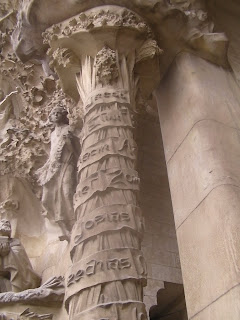I realize that I have so much to say about this place, so I'm gonna cut it into two entries: One for the basilica, and another for the math.
This is probably what's going to be my favorite site for the whole trip. I don't know where to begin in describing it. The many intricacies, the attention to detail, numerous symbolisms and the mathematical concepts behind its design. All these come together to bring to life a basilica that is both unreal yet natural in its appearance.
It's claim to fame is that it's actually unfinished. The great architect Antonio Gaudi, who was working on it for many years, suddenly died in a tram accident in 1926. He came closest to completing the Nativity facade, but otherwise most of the basilica was left unfinished. Through the plans that he has left behind a team of many people continue the work on the basilica.
The cranes are a constant presence at the basilica
The Sagrada Familia immediately catches the eye though because it's different. The sculptures and design used appear to be much more modern than the usual basilica. The first thing that welcomes me as I visit is the passion facade.

The entire facade presents sculptures that depict scenes from the passion of Christ. Looking at it as whole, I can't help but feel that it's a very rigid display. There are almost no curves. It was made that way to convey a sense of rockiness and roughness to deepen the emotion of devastation involved with the passion.
Here you can see Christ being presented to the people. He is flanked by two roman guards, and it's easy to notice their appearance. It seems almost sinister, especially in the design of their helmets. On the far right is actually Pontius Pilate, washing his hands of guilt.

The central image of the facade is Veronica wiping the face of Jesus. This is one of the few parts that appears soft and smooth: the cloth and the face of Jesus. Behind her are the soldiers again with their imposing helmets and Jesus with the women of Jerusalem. and...

Directly above that, (I skipped a lot of scenes) is the ascension sculpture. I can't recall what it's made of, but it is no longer carved out of stone like the rest of the facade. It rests on a bridge about 40 meters above ground and connecting two of the spires of the church.
The passion facade also has this:
It is a magic square beside the statue of Judas' kiss of betrayal. The magic square sums up to 33 (the age when Jesus died) when you go horizontally, vertically or diagonally. Supposedly though, it sums up to 33 in many other ways too. But.. More on that later..
Moving on inside.
The nicest thing about the church for me is a subtle but effective feature. The lighting in the church is just right. It's not something that would strike you immediately. But when you compare it to the other cathedrals around the world, you'll notice that most are dark and musty while this one is actually very well lit, but not so bright as to be blinding. Too little light or too much light can both bother the sight.
(Yet) another amazing feature of the church are its columns. Inside the church, there are 4 different types of columns.
You can see that the three columns on the left are the same. Then the right ones have three different types. The ones on the left are made of sandstone, then from front to back on the right, they're granite, basalt and porphyry. In that same order, each one is successively thicker in diameter, depending on how much load they have to bear. Not only do they differ in diameter, but they also increase in number of sides. The sandstone columns have 6 sides, then each successive column has 2 more sides. Again, more on the columns later..
The last part of the tour is the nativity facade, which is on the opposite side of the church to the passion facade. Unlike the passion facade which is bare and rigid, the nativity facade is completely joyous. All around are carving of all sorts of animals or things from nature, all celebrating the nativity.

St. Joseph's enclave
Just one last really cool detail: The pillar that supports the statue of Jesus on the nativity facade is entwined with names with the genealogy of Jesus. You can see at the very top there's Jacob there. I'm not so sure who the other names are..

More on the math soon!





No comments:
Post a Comment